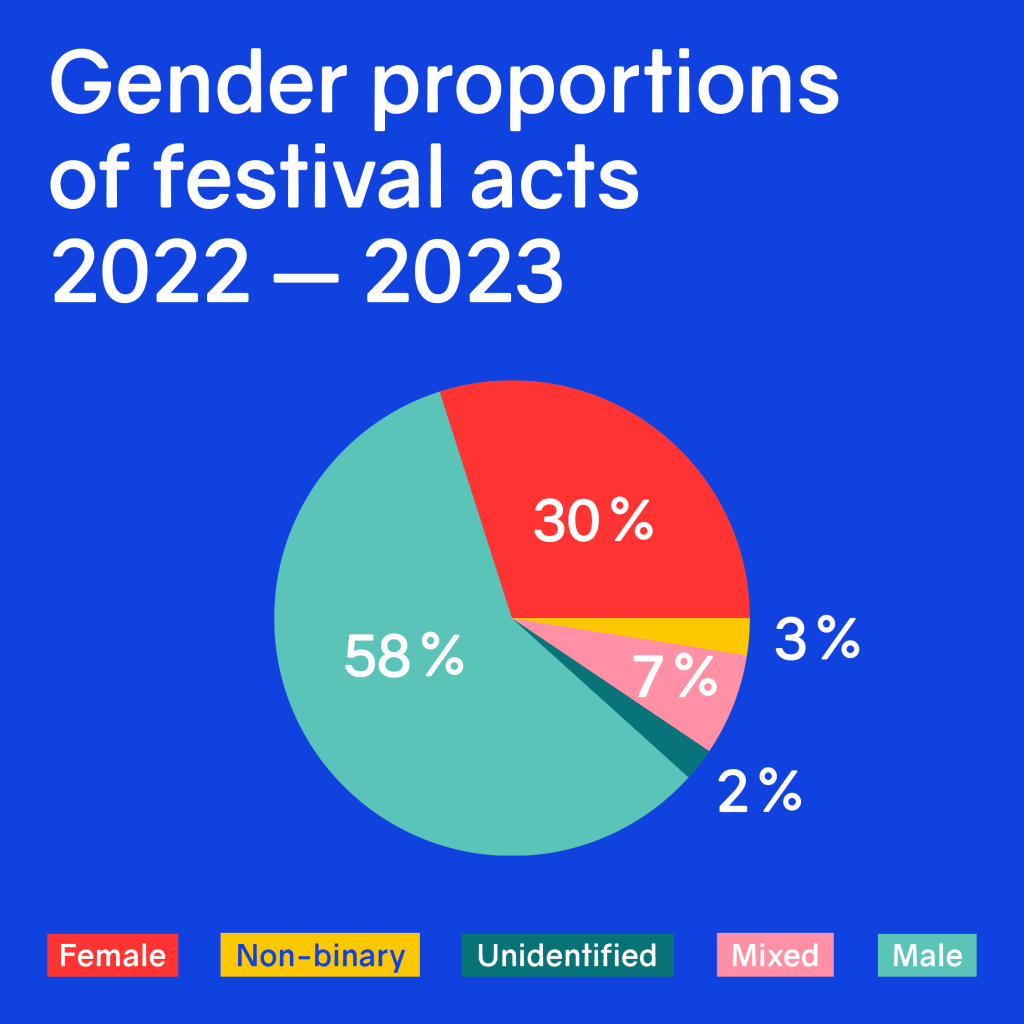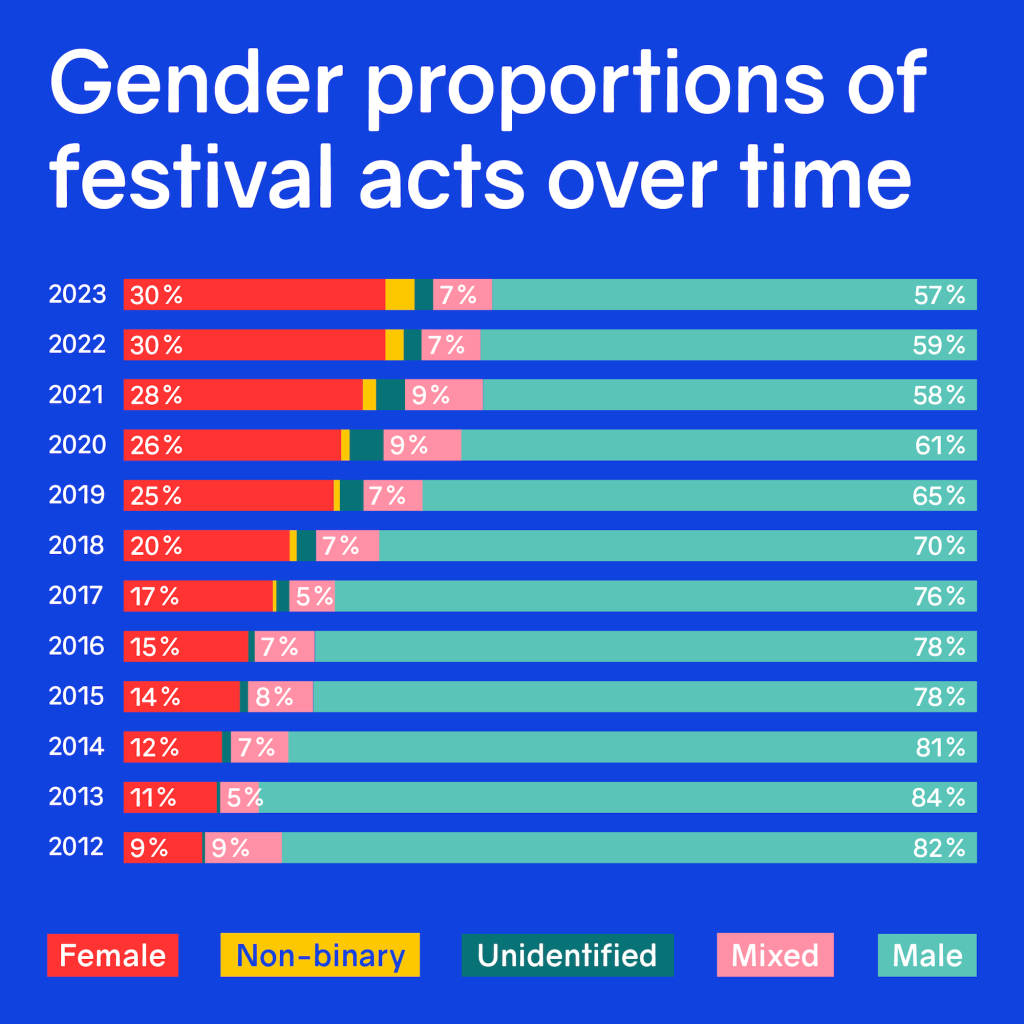In the latest volunteer-run FACTS study, women and nonbinary artists are making steady, if slow, progress in representation across festivals. But the larger the festival, the less balanced the gender representation.
This is the sixth FACTS report run by volunteers from the female:pressure network, published today on International Women’s Day (which is now a holiday here in Berlin), and following previous editions in 2013, 2015, 2017, 2020, and 2022. It’s a true volunteer, grassroots effort, from methodology to collection – the group has informally dubbed itself “the troublemakers.” There’s no funding, and no official institutional involvement; this is all hashed out by a group of active members. And they work really, really hard. Even as official responses from festivals have lagged a bit in recent years (for unknown reasons), there was greater data collected this year by the volunteers than any previous year.

Graph images by Elisa Metz.
The data covers the span 2012 – 2023, and taken across the decade-plus, the progress is notable – 43% non-male representation up from a truly depressing 18% back in 2012. It’s also notable that “nonbinary” and “unidentified” as categories have grown from essentially nonmeasurable responses in early reports to sizable slices now. I’m not going to get into the discussion of categorization and reinforcement of binaries – there is some mention of their conversations on those topics in the report, though. Generally, the full report is worth a read, beyond just the graphs, as some of the most interesting and challenging discussions do happen like that in the margins.
I expect anyone who cares about this issue is already scanning lineups. So it’s some of the correlations that are maybe most worth mentioning:
Larger festivals tend to have lower proportions of female and non- binary acts. Publicly funded festivals and festivals with female artistic directors have higher proportions of female acts.
… there is a continued trend of the largest festivals booking the fewest female and nonbinary acts. Indeed, the smaller the festival, the more gender diverse its line-up is likely to be. There is clearly still a significant imbalance in gender representation on electronic music festival stages today.
Also worth highlighting: seeing this as a systemic issue:
Structural sexism perpetuates inequality by creating barriers and disincentives for artists of marginalized genders, limiting success in the arts to the status quo. While this phenomenon is receiving more media coverage today, we believe that measuring trends through the FACTS study is necessary to understand developments in the electronic music industry and to hold decision-makers accountable.
“The smaller the festival, the more gender diverse its line-up is likely to be.”
FACTS 2024 report

The report does not attempt to look at imbalances in pay and other resources, but it’s fair to assume that the “largeness” metric also correlates to a pay gap. Completely unscientifically and anecdotally, it seems like many club lineups have non-male representation that’s higher than what we see in the report – but that often includes early-career artists who absolutely get less pay than big headliners with bookers.
Some of the positives in this report also mask deeper imbalances in our culture and the music and music tech industries. It’s clear that a lot of progress has been made in DJ bookings, but representation in labels, label ownership, music production, music technology engineering, leadership, business ownership, and studio work are woefully still male-dominated. Apart from being unethical and unjust, that stunts the development of these communities, industries, and practices.
Also, buried in the report – Slovenia and Sweden top representation stats by country (for countries with 10+ festivals), with proportions roughly balanced around 50/50 male/female-nonbinary. The USA, Croatia, Japan, Czechia, and Ireland all rank poorly, with Mexico, Russian Federation, and Portugal at the bottom.
There are other studies cited in the same report which also merit some mention. For instance, TuneCore/Believe’s Be The Change study, the perception of whether gender discrimination is a problem is itself more likely perceived by women/nonbinary artists and professionals then men. (Okay, no surprise there.) But these numbers are staggering: “Women are +25% more likely to report being told that their gender is not a good fit for a job. Nonbinary individuals are +200% and transgender individuals are +250% more likely to report being told the same.”
Women are +25% more likely to report being told that their gender is not a good fit for a job. Nonbinary individuals are +200% and transgender individuals are +250% more likely to report being told the same
TuneCore/Believe’s Be The Change study
These studies don’t look at BIPOC or other marginalized categories – and it’s good they don’t, actually; evaluating people’s racial background by anything other than voluntary means is deeply problematic. But I think you can apply the lessons about structural bias and change to other issues around marginalization – institutionalized racial discrimination, ableism, bias against queer people, or take your pick. And it’s worth asking what efforts could do a better job of evaluating event programming on those issues.
Read the full report:
FACTS 2024 [female:pressure blog, with download links in low- and high-res PDF]
By the way, as I said, I think one danger at just looking at festival bookings is, that focuses narrowly on the role of DJ. That’s not in any way a criticism of female:pressure and FACTS – the work they do on this report is epic! It’s more that those of us in the press and advocacy need to look more broadly.
So, as I write this from Germany – which is at the bottom of the heap in Europe (very much including eastern Europe) when it comes to female STEM graduates – here is a quick look at one organization in the US that’s doing great things. WAM (Women’s Audio Mission, though now gender-expansive) does everything from mentoring studio work to building synthesizers. This could be a great model for other community efforts – and we could be doing a lot better in Europe, which is crazy given the amount of government resources here.
And for intersectional efforts in education working on underrepresented Black Americans, look back to the incredible Willie Mae program: